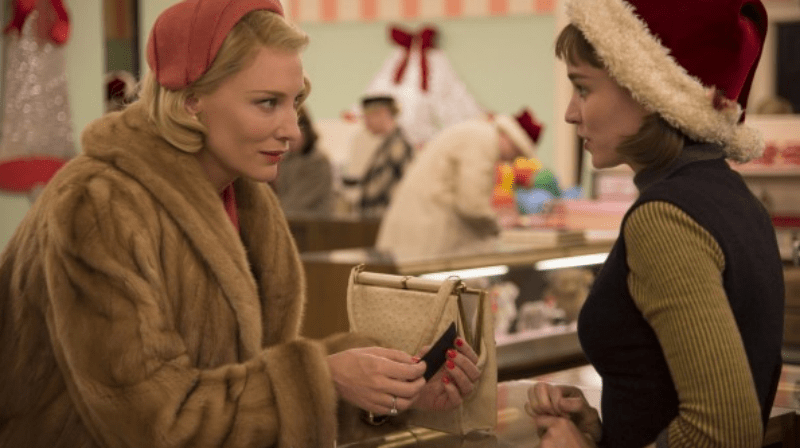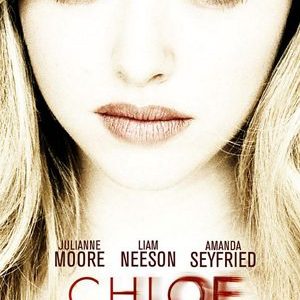
For lesbians, ‘Carol’ is the most anticipated film of the year.
I don’t know a literary lesbian who hasn’t read The Price of Salt, Patricia Highsmith’s extraordinary (and rather unlike-herself) novel.
Highbrow pulp fiction meets lesbian road trip, The Price of Salt—published in 1952 under the pseudonym Claire Morgan and reissued as Carol in the 1990s with an afterword by Highsmith herself—was an instant lesbian cult classic, and still is.
Its strong visuals and inherent momentum felt cinematic, and so a generation or two of lesbians have long hoped for a film adaptation. The process for one began in 1999 with novice screenwriter Phyllis Nagy assigned to the task.
Getting the film made was a long and arduous road, with numerous twists and turns and detours, to finally bring the project to fruition last year, and now to its limited cinema release this week.
Unlike Highsmith’s other works, some of which were adapted for the cinema during her lifetime—adaptations that emphasized especially the complex amorality of their male characters—Carol was based on aspects of Highsmith’s own personality, experience, and her New York life; it was also unwaveringly female—it displayed more tenderness, interiority, and a sense of justice absent in her other works.
Highsmith, like the protagonist Therese, worked Christmas retail rush in the children’s toy department of a major NYC department store. Unsurprisingly, the lemony Highsmith loathed this temp job, but she needed the money. The saving grace of this gig was a very brief encounter that formed the basis of the character of Carol Aird.
One day, Highsmith, a clerk, sold a doll to a “blondish woman in a fur coat.” Something about the woman struck Highsmith, and she took her customer’s details, and like a good detective—or a good lesbian—she stalked her. In her journal, Highsmith admitted there was something psychopathic about her attraction to the woman, who, no doubt led an ordinary heterosexual suburban life in New Jersey. Highsmith was acutely aware of her ‘criminal’ feelings and used the incident to ask that question beloved by fiction writers, or detectives:
What if?
The result was Therese Belivet, a 19-year-old theatre student who encounters the older but not necessarily wiser Carol Aird shopping for a doll for her daughter, is magnetically attracted to her, and feels a flicker of reciprocation.
Somewhat taken with Therese, Carol leaves her gloves on the counter and, in order to return them, Therese accesses Carol’s customer records. It is the one decisive act from Therese who freely admits that she “barely knows what to order for lunch,” and which sets in motion a chain of events that leads to an unlikely affair between the two women. It’s also an affair that has a tinge of crime to it since in the 1950s legal repercussions could, and do ensue.
If you haven’t read the book the plot will hook you, and if you have read the book you’ll still be in a state of suspense, and hopefully pleased by a number of Nagy’s changes that make the adaptation screen worthy. Add to that the film’s precise production design, the sincere if stylized performances, the gorgeous monochromatic colour palette, striking costumes, and a moody original score, and you have enough to make Oscar take notice.
In the New York press conference for the film’s opening, held at JW Marriott Essex House on Monday, November 16, it was clear that the women are the stars of this film—literally, but also in the sense that they are the main attraction, which is rare in an industry where male characters (and filmmakers) continue to have privileged roles both in front of and behind the cameras.
Rooney Mara, who plays Therese, acknowledged that her character had many layers and complex motivations. Therese knew exactly what she was doing—instigating—when she sent Carol the gloves. Sarah Paulson, who plays Carol’s ex, Abby, says that she played the role with friendship and loyalty in mind. “Abby still has feelings for Carol…I wonder what I personally would do…if I was called upon to come and rescue the person that [somebody I once loved] currently loves. To me, it was a testament to her love, and her desire to be around Carol and in Carol’s orbit no matter what.”
Blanchett found the aspect of Carol’s motherhood particularly juicy to play. In pursuing love with Therese she is risking her ability to maintain a relationship with her small daughter, Rindy. When Carol makes a choice based on her own survival “she risks losing the audience’s sympathy. If it was a gay man somehow I don’t think the question of sympathy would arise. Whenever one plays a mother on the screen there’s always a sense that there is a right way to parent and you lose your sense of identity and become a mother first and foremost. That’s what I loved about [director] Todd [Haynes]; he didn’t even talk about sympathy. And personally, as an actor, I find the idea of playing for an audience’s sympathy a kind of repulsive endeavour.”
Writer Phyllis Nagy added, “Carol is being a good mother…Carol must be who she is; she’s not yet who she is. In order for her to be good for her child, and not screw her up, later on, she’s got to do this. It’s actually quite selfless.”
While in the book the character of Carol Aird is conveyed to readers through Therese’s point of view, and therefore we never really get to know her, Nagy was keen to give viewers direct access to Carol, her hopes and her desires. Haynes accentuates this in his direction, using framing devices—through doorways and windows and camera viewfinders—inviting the viewer to look at the characters looking at each other.
Blanchett noted that Haynes’ focus on “the gaze” produces much of the dramatic tension in the film. “If a cigarette was held in a certain way, and perceived by the camera in a certain way, it’s because it was being viewed through the prism of someone’s desire rather than the prism of the period,” she said. While set in the early 1950s, the film “completely subverts” much of the artificiality and conventions that Blanchett associates with the period to create immediacy, universality and freshness: “People in clothes, not in costumes, existing and behaving with one another, as we do now. I think when you experience a love story…it feels as if it’s this timeless connection.”
As to the film depicting a lesbian relationship, as opposed to simply a relationship, Blanchett did not waver from her previous stance that this is not a story about ‘The Love That Dare Not Speak Its Name’; it’s just a love story. “You mean normal,” she said emphatically to a journalist who asked her to describe the relationship between Carol and Therese. “To me there is no difference,” agreed Rooney Mara about whether it was a lesbian romance or not. “One of the great things about the film is that it’s not a political film, it’s not a film with an agenda, we’re not preaching to the audience, and so people are allowed to watch it for what it is, which is a love story between two humans.”
Phyllis Nagy, producer Christine Vachon, and the always excellent Sarah Paulson in a supporting role aside, this is not a lesbian film. So if you’re expecting the overheated, talkative, coming-out-and-suffering narrative that is characteristic of so many lesbian films, you’ll be disappointed. Carol is a studied and somewhat chilly film, as is characteristic of the narratives of both Highsmith and Haynes. But it’s destined to be a modern classic. The pleasure derived from this film comes not so much from cathartically living through our own minority status as it does from watching professionals who are at the top of their game bring this cherished story to life with utter conviction and a sense of purpose.


